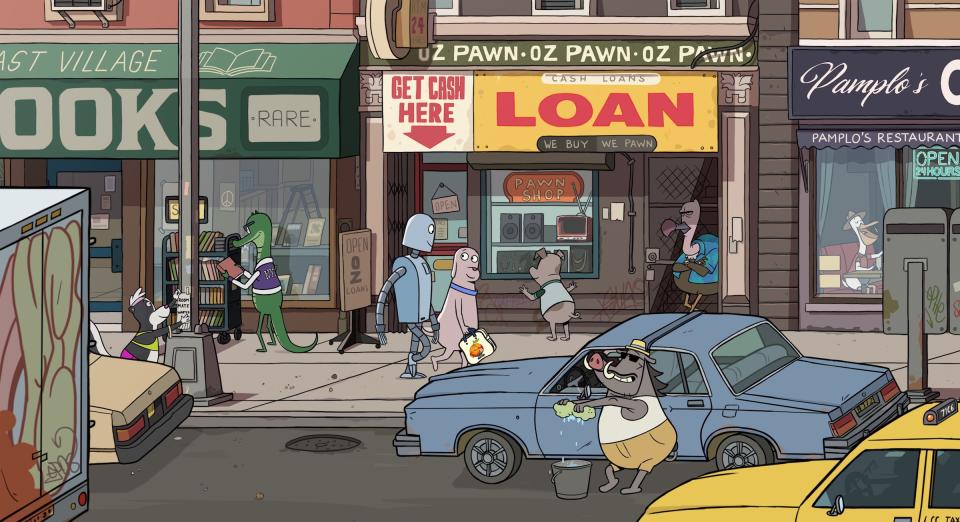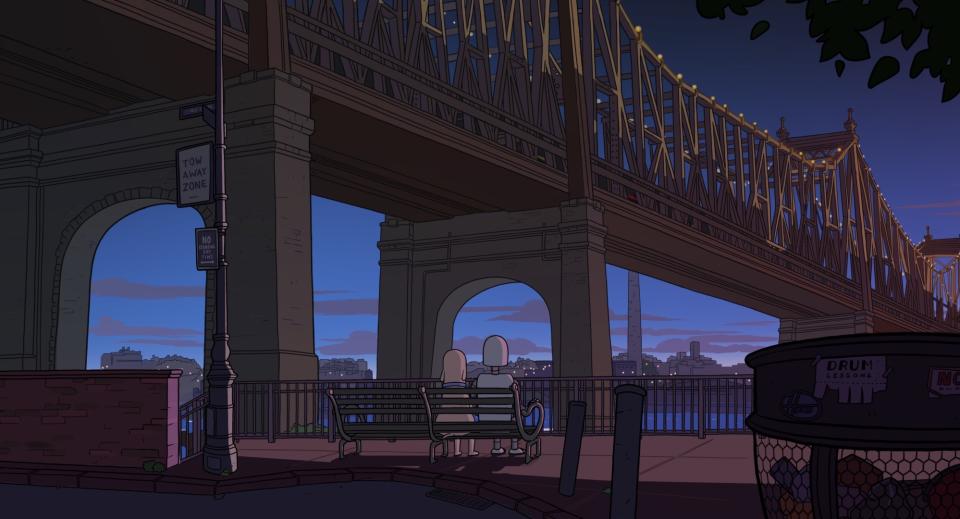Robot Dreams Is a Joyous Ode to Friendship and '80s New York
- Oops!Something went wrong.Please try again later.
- Oops!Something went wrong.Please try again later.
In animation, the simplest things can have the biggest impact: the jaunty swish of a dog’s pointed tail, a day-at-the-beach scene rendered in jellybean colors, the way a snowflake drifting from the sky awakens a sleeping beauty, Wizard of Oz–style. Spanish director Pablo Berger’s gorgeous animated film Robot Dreams—adapted from a graphic novel by Sara Varon—is the sum of details like that, and the result is so joyously, casually poetic that you barely feel prepared for the story’s deeply affecting ending. But that ending is what makes Robot Dreams sing. This is a movie that feels, in the best way, like the last day of summer: radiant, bittersweet, redolent of memories in the making.
Robot Dreams, set in 1980s New York, opens in a classic East Village apartment, where a solitary dog named Dog slumps on his sofa watching TV and playing video games. When he turns off the tube, he sees his lonely reflection in the screen; it’s too much to bear. Then he sees an ad for a robot he can order by mail. Why not? Minutes later, ACME-style, the mail truck drops off the box, and Dog gets to work assembling his new robot friend, who, after a few false starts in the setup process, bleeps to life before his eyes. Robot and Dog head out to explore the streets of New York, a world of pay phones, of subway tokens sold in 10-packs, of little metal boxes that will dispense a newspaper for a few coins. This now-vanished world is their playground, a universe of grubby wonders; though Dog has seen it all before, he experiences it anew through Robot, who’s delighted by every sight and sound.

This half-real, half–nostalgic fantasy New York is populated by anthropomorphized animals: yaks in business suits, gazelles in dresses and lipstick, a bunch of leather-clad critter punks standing on the street corner puffing cigarettes. Somehow, it all makes perfect sense. In the subway, Dog and Robot encounter an octopus banging on a makeshift drum kit, a panoply of upside-down plastic tubs—he thumps away at them with his multiple arms, and though Dog barely notices the sound at first, he starts to groove when he sees Robot shuffling and swaying to the beat. In Central Park, the two don skates and perform an impromptu roller-dance to Earth Wind & Fire’s “September.” It will become their theme song, reprised throughout the story, in moments both exuberant and wrenching.
Read more: The 100 Best Movies of the Past 10 Decades
Because Dog and Robot's city reverie is short-lived. Disaster strikes after they enjoy a marvelous day at the beach. Water doesn’t agree with metal joints; Robot, after happily dozing off in the sun, awakens to realize he can’t move, and he’s too heavy for Dog to lift. Dog reluctantly leaves his friend behind, ablaze with determination to return for him. One circumstance after another prevents that, but Dog never forgets about Robot, nor does Robot forget about Dog. The rest of the movie shows how each holds the other tight in their thoughts and dreams. Even apart, they’re always together.

There’s lots of vibrant sound and color in Robot Dreams, but it’s completely wordless. Every thought and idea is communicated with a glance, a shrug, a smile, an impromptu soft shoe—this isn’t just animation, but a kind of narrative dance. (That’s not so surprising if you’ve seen the movie for which Berger is best known, 2012’s Blancanieves, a silent-film retelling of Snow White.) There are marvelous set pieces, like a dream sequence in which a field of daisies becomes a troupe of tap dancers—they’re half Silly Symphony, half Busby Berkeley. And late in the film, a third character makes an entrance: he’s a raccoon named Rascal, and he works as a building super and handyman. He becomes a part of Robot and Dog’s world, a kind of caretaker of their story; he fills the role that we want to, but can’t.
I realize that sounds vague, but to even hint at the ending of Robot Dreams—which was nominated for a 2023 Oscar, but is only just now opening in theaters—would do it a disservice. In the broad sense, this is a movie about the rarity and mutability of love and companionship, though more specifically, it could be the ultimate breakup film, a way of seeing a radiant future beyond the pain of separation. The ending of Robot Dreams is resplendent and restorative, so happy-sad that it’s likely to linger with you for days. It’s like a mantle of grace—a blessing you didn’t see coming, and one you didn’t know you needed.
Contact us at letters@time.com.

